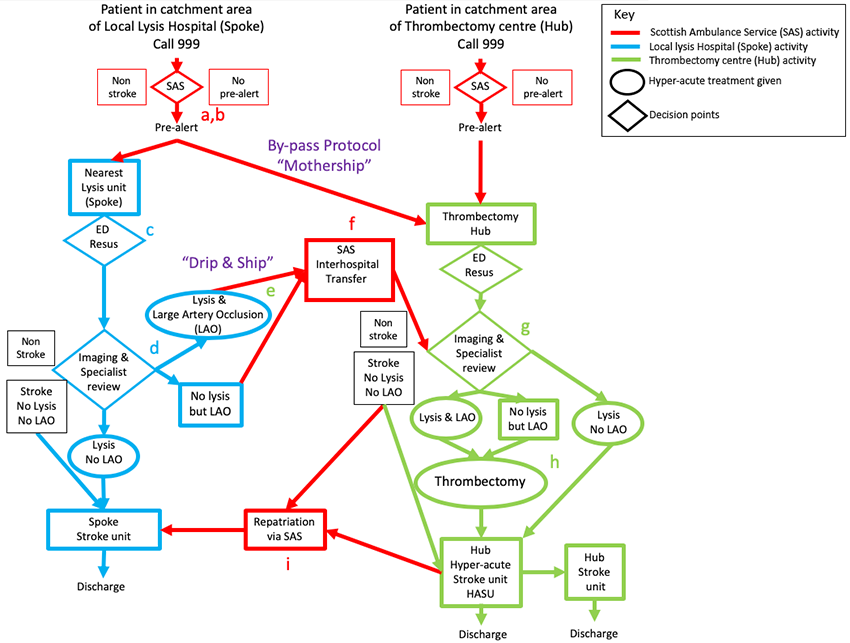Jimmy was admitted to the hyperacute stroke unit to monitor his condition. His blood pressure was initially very high, so he was treated with intravenous GTN for 24 hours and then switched to oral blood pressure lowering medication.
- NHS Lothian: GTN protocol thrombectomy April 2020 [.pdf, 115 KB]
- NHS Lothian: Labetalol protocol thrombectomy April 2020 [.pdf, 126 KB]
He was stable so was repatriated for further stroke unit care to his local (spoke) hospital. He made a good recovery and is now living back home with his wife. He is taking more exercise and is trying to stop smoking. He is hoping to get back to fishing soon.
Here is the complex diagram showing the possible pathways to thrombolysis and thrombectomy we saw in the Introduction to this module.

Jimmy’s pathway
Select True or False for each statement about Jimmy’s actual pathway.
Jimmy’s pathway
Actual pathway
Patient in catchment area of Local Lysis Hospital (Spoke) Call 999 → SAS → Pre-alert → By-pass Protocol “Mothership” → Thrombectomy Hub → ED Resus → Imaging & Specialist review → Stroke No Lysis No LAO → Hub Hyper-acute Stroke unit HASU → Repatriationvia SAS → Spoke Stroke unit → Discharge
Ideal pathway
Patient in catchment area of Local Lysis Hospital (Spoke) Call 999 → SAS → Pre-alert → Nearest Lysis unit (Spoke) → ED Resus → Imaging & Specialist review → Stroke No Lysis No LAO → Spoke Stroke unit → Discharge
Select True or False for each statement about Jimmy’s actual pathway.
Jimmy had one extra ambulance journey – True – he needed a second journey to repatriate him to his local hospital.
The longer initial ambulance journey had no important consequences – False – the ambulance was unavailable to attend other emergencies for longer – other patients may have had worse outcomes as a result.
His care was split between two hospitals – True – he spent time in two hospitals, rather than one which will have reduced continuity and made communication more difficult.
His wife and family had to travel further to visit – True – they had to spend an extra hour each day travelling to the thrombectomy hub – they were not familiar with this journey and got lost!
There was less continuity of care – True – he was looked after by two medical teams, instead of one which complicated communications and increased the risk of something going wrong.
Jimmy benefitted from treatment which was not available at his local hospital – False – all of the treatments he received are available in all spoke hospitals.


